 Household borrowing on credit cards and through overdrafts and loans has been growing rapidly. This ‘unsecured’ borrowing is now rising at rates not seen since well before the credit crunch of 2008 (click here for a PowerPoint of the chart below). Should this be a cause for concern?
Household borrowing on credit cards and through overdrafts and loans has been growing rapidly. This ‘unsecured’ borrowing is now rising at rates not seen since well before the credit crunch of 2008 (click here for a PowerPoint of the chart below). Should this be a cause for concern?
Household confidence is generally high and, as a result, people continue to take out more loans and so household debt continues to increase. Saving rates are falling and, at 5.1% of household disposable income, are the lowest rate since 2008, mirroring the high levels of spending and borrowing.
But as long as the economy keeps growing and as long as interest rates stay at record low levels, people should be able to continue servicing this rising debt. Indeed, with generous balance transfer offers between credit cards and many people paying off their full balance each month, only 56.6% are paying any interest at all on credit card debt, the lowest level on record.
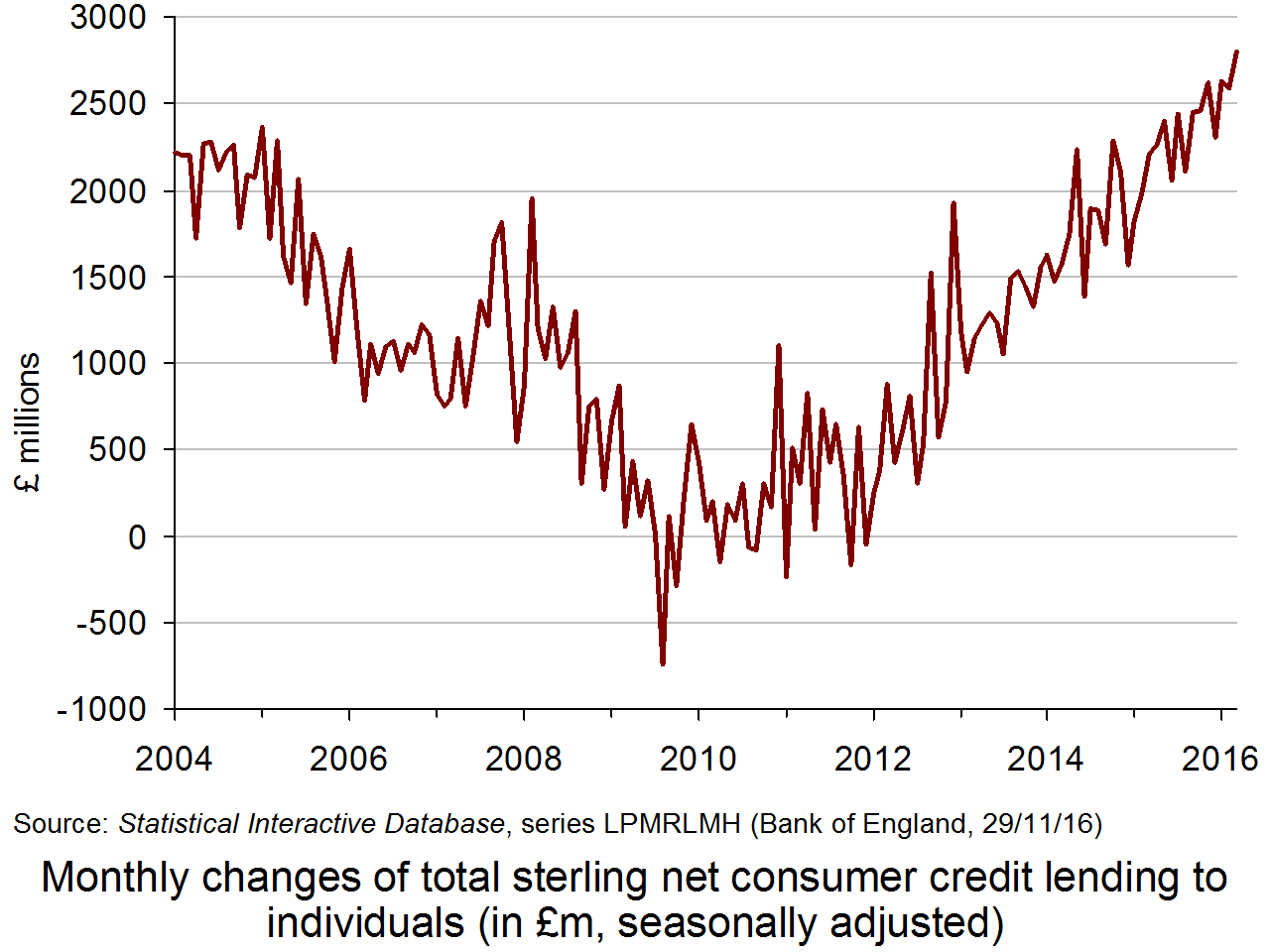 But there could be trouble ahead! Secured borrowing (i.e. on mortgages) is at record highs as house prices have soared, limiting the amount people have to left to spend, even with ultra low interest rates. Student debt is growing, putting a brake on graduate spending.
But there could be trouble ahead! Secured borrowing (i.e. on mortgages) is at record highs as house prices have soared, limiting the amount people have to left to spend, even with ultra low interest rates. Student debt is growing, putting a brake on graduate spending.
With economic growth set to slow and inflation set to rise as the effects of the lower pound filter through into retail prices, this could initially boost borrowing further as people seek to maintain levels of consumption. But then, if unemployment starts to rise and consumer confidence starts to fall, real spending could decline, putting further downward pressure on the economy.
Confidence could then fall further and we could witness a repeat of 2008–9, when people became worried about their levels of borrowing and cut back on consumption in an attempt to claw down their debt. The economy was pushed into recession.
The Bank of England is well aware of this scenario and wants banks to ensure that their customers can afford loans before offering them.
Articles
Bank governor Mark Carney warns on household debt BBC News, Brian Milligan (30/11/16)
Credit crunch: Household debt is rising just as the economy’s future is uncertain The Telegraph, Tim Wallace (10/12/16)
Bank of England publication
Financial Stability Report, November 2016 Bank of England (30/11/16)
Data
Money and lending Bank of England Interactive Database
United Kingdom Households Debt To GDP Trading Economics
Household debt OECD Data
Questions
- What determines the amount people borrow?
- What would cause people to cut back on the amount of debt they have?
- Distinguish between secured and unsecured borrowing and debt.
- Why has secured borrowing risen? Does this matter?
- What is meant by the term ‘re-leveraging’? What is its significance in terms of household borrowing?
- Find out what the affordability tests are for anyone wanting to take out a mortgage.
- What are the greatest risks to UK financial stability?
 On 14 December, the US Federal Reserve announced that its 10-person Federal Open Market Committee (FOMC) had unanimously decided to raise the Fed’s benchmark interest rate by 25 basis points to a range of between 0.5% and 0.75%. This is the first rise since this time last year, which was the first rise for nearly 10 years.
On 14 December, the US Federal Reserve announced that its 10-person Federal Open Market Committee (FOMC) had unanimously decided to raise the Fed’s benchmark interest rate by 25 basis points to a range of between 0.5% and 0.75%. This is the first rise since this time last year, which was the first rise for nearly 10 years.
The reasons for the rise are two-fold. The first is that the US economy continues to grow quite strongly, with unemployment edging downwards and confidence edging upwards. Although the rate of inflation is currently still below the 2% target, the FOMC expects inflation to rise to the target by 2018, even with the rate rise. As the Fed’s press release states:
Inflation is expected to rise to 2% over the medium term as the transitory effects of past declines in energy and import prices dissipate and the labor market strengthens further.
The second reason for the rate rise is the possible fiscal policy stance of the new Trump administration. 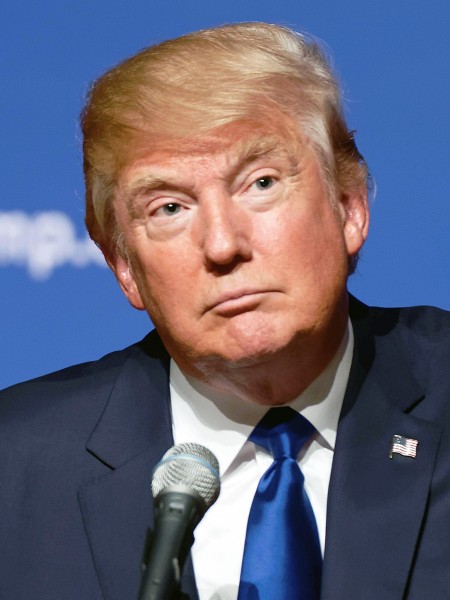 If, as expected, the new president adopts an expansionary fiscal policy, with tax cuts and increased government spending on infrastructure projects, this will stimulate the economy and put upward pressure on inflation. It could also mean that the Fed will raise interest rates again more quickly. Indeed, the FOMC indicated that it expects three rate rises in 2017 rather than the two it predicted in September.
If, as expected, the new president adopts an expansionary fiscal policy, with tax cuts and increased government spending on infrastructure projects, this will stimulate the economy and put upward pressure on inflation. It could also mean that the Fed will raise interest rates again more quickly. Indeed, the FOMC indicated that it expects three rate rises in 2017 rather than the two it predicted in September.
However, just how much and when the Fed will raise interest rates again is highly uncertain. Future monetary policy measures will only become more predictable when Trump’s policies and their likely effects become clearer.
Articles
US Federal Reserve raises interest rates and flags quicker pace of tightening in 2017 Independent, Ben Chu (14/12/16)
US Federal Reserve raises interest rates: what happens next? The Telegraph, Szu Ping Chan (15/12/16)
Holiday traditions: The Fed finally manages to lift rates in 2016 The Economist (14/12/16)
US raises key interest rate by 0.25% on strengthening economy BBC News (14/12/16)
Fed Raises Key Interest Rate, Citing Strengthening Economy The New York Times, Binyamin Appelbaum (14/12/16)
US dollar surges to 14-year high as Fed hints at three rate hikes in 2017 The Guardian, Martin Farrer and agencies (15/12/16)
Questions
- What determines the stance of US monetary policy?
- How does fiscal policy impact on market interest rates and monetary policy?
- What effect does a rise in interest rates have on exchange rates and the various parts of the balance of payments?
- What effect is a rise in US interest rates likely to have on other countries?
- What is meant by ‘forward guidance’ in the context of monetary policy? What are the benefits of providing forward guidance?
- What were the likely effects on the US stock market of the announcement by the FOMC?
- Following the FOMC announcement, two-year US Treasury bond yields rose to 1.231%, the highest since August 2009. Explain why.
- For what reason does the FOMC believe that the US economy is already expanding at roughly the maximum sustainable pace?
 We’ve considered Keynesian economics and policy in several blogs. For example, a year ago in the post, What would Keynes say?, we looked at two articles arguing for Keynesian expansionary polices. More recently, in the blogs, End of the era of liquidity traps? and A risky dose of Keynesianism at the heart of Trumponomics, we looked at whether Donald Trump’s proposed policies are more Keynesian than his predecessor’s and at the opportunities and risks of such policies.
We’ve considered Keynesian economics and policy in several blogs. For example, a year ago in the post, What would Keynes say?, we looked at two articles arguing for Keynesian expansionary polices. More recently, in the blogs, End of the era of liquidity traps? and A risky dose of Keynesianism at the heart of Trumponomics, we looked at whether Donald Trump’s proposed policies are more Keynesian than his predecessor’s and at the opportunities and risks of such policies.
The article below, Larry Elliott updates the story by asking what Keynes would recommend today if he were alive. It also links to two other articles which add to the story.
Elliott asks his imaginary Keynes, for his analysis of the financial crisis of 2008 and of what has happened since. Keynes, he argues, would explain the crisis in terms of excessive borrowing, both private and public, and asset price bubbles. The bubbles then burst and people cut back on spending to claw down their debts.
 Keynes, says Elliott, would approve of the initial response to the crisis: expansionary monetary policy (both lower interest rates and then quantitative easing) backed up by expansionary fiscal policy in 2009. But expansionary fiscal policies were short lived. Instead, austerity fiscal policies were adopted in an attempt to reduce public-sector deficits and, ultimately, public-sector debt. This slowed down the recovery and meant that much of the monetary expansion went into inflating the prices of assets, such as housing and shares, rather than in financing higher investment.
Keynes, says Elliott, would approve of the initial response to the crisis: expansionary monetary policy (both lower interest rates and then quantitative easing) backed up by expansionary fiscal policy in 2009. But expansionary fiscal policies were short lived. Instead, austerity fiscal policies were adopted in an attempt to reduce public-sector deficits and, ultimately, public-sector debt. This slowed down the recovery and meant that much of the monetary expansion went into inflating the prices of assets, such as housing and shares, rather than in financing higher investment.
He also asks his imaginary Keynes what he’d recommend as the way forward today. Keynes outlines three alternatives to the current austerity policies, each involving expansionary fiscal policy:
|
|
| • |
Trump’s policies of tax cuts combined with some increase in infrastructure spending. The problems with this are that there would be too little of the public infrastructure spending that the US economy needs and that the stimulus would be poorly focused. |
| • |
Government taking advantage of exceptionally low interest rates to borrow to invest in infrastructure. “Governments could do this without alarming the markets, Keynes says, if they followed his teachings and borrowed solely to invest.” |
| • |
Use money created through quantitative easing to finance public-sector investment in infrastructure and housing. “Building homes with QE makes sense; inflating house prices with QE does not.” (See the blogs, A flawed model of monetary policy and Global warning). |
Increased government spending on infrastructure has been recommended by international organisations, such as the OECD and the IMF (see OECD goes public and The world economic outlook – as seen by the IMF). With the rise in populism and worries about low economic growth throughout much of the developed world, perhaps Keynesian fiscal policy will become more popular with governments.
Article
Keynesian economics: is it time for the theory to rise from the dead?, The Guardian, Larry Elliott (11/12/16)
Questions
- What are the main factors determining a country’s long-term rate of economic growth?
- What are the benefits and limitations of using fiscal policy to raise global economic growth?
- What are the benefits and limitations of using new money created by the central bank to fund infrastructure spending?
- Draw an AD/AS diagram to illustrate the effect of a successful programme of public-sector infrastructure projects on GDP and prices.
- Draw a Keynesian 45° line diagram to illustrate the effect of a successful programme of public-sector infrastructure projects on actual and potential GDP.
- Why might an individual country benefit more from a co-ordinated expansionary fiscal policy of all countries rather than being the only country to pursue such a policy?
- Compare the relative effectiveness of increased government investment in infrastructure and tax cuts as alterative forms of expansionary fiscal policy.
- What determines the size of the multiplier effect of such policies?
- What supply-side policies could the government adopt to back up monetary and fiscal policy? Are the there lessons here from the Japanese government’s ‘three arrows’?

The first article below, from The Economist, examines likely macroeconomic policy under Donald Trump. He has stated that he plans to cut taxes, including reducing the top rates of income tax and reducing taxes on corporate income and capital gains. At the same time he has pledged to increase infrastructure spending.
This expansionary fiscal policy is unlikely to be accompanied by accommodating monetary policy. Interest rates would therefore rise to tackle the inflationary pressures from the fiscal policy. One effect of this would be to drive up the dollar and therein lies significant risks.
The first is that the value of dollar-denominated debt would rise in foreign currency terms, thereby making it difficult for countries with high levels of dollar debt to service those debts, possibly leading to default and resulting international instability. At the same time, a rising dollar may encourage capital 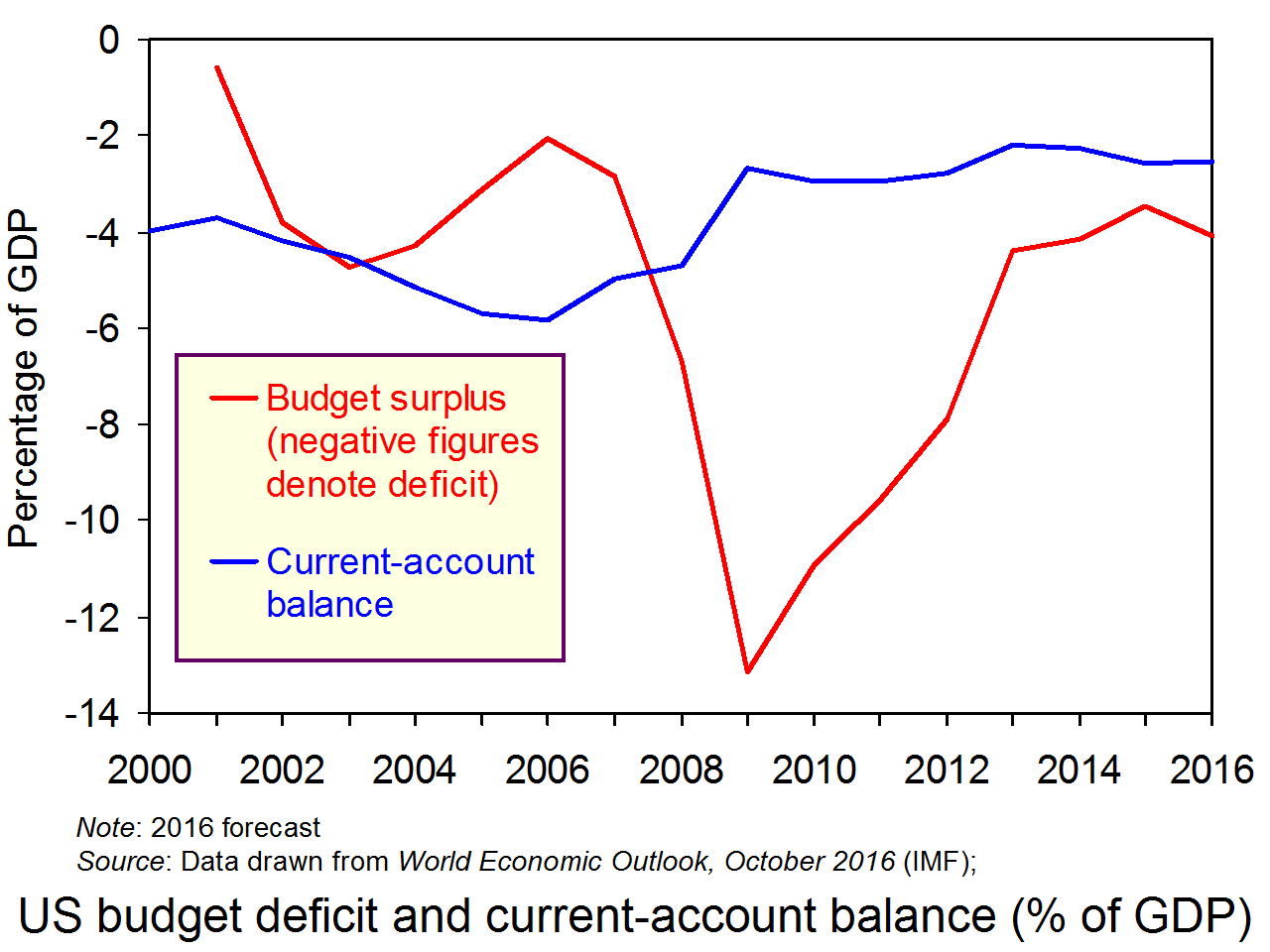 flight from weaker countries to the US (see The Economist article, ‘Emerging markets: Reversal of fortune’).
flight from weaker countries to the US (see The Economist article, ‘Emerging markets: Reversal of fortune’).
The second risk is that a rising dollar would worsen the US balance of trade account as US exports became less competitive and imports became more so. This may encourage Donald Trump to impose tariffs on various imports – something alluded to in campaign speeches. But, as we saw in the blog, Trump and Trade, “With complex modern supply chains, many products use components and services, such as design and logistics, from many different countries. Imposing restrictions on imports may lead to damage to products which are seen as US products”.
The third risk is that the main beneficiaries of Trump’s likely fiscal measures will be the rich, who would end up paying significantly less tax. With all the concerns from poor Americans, including people who voted for Trump, about growing inequality, measures that increase this inequality are unlikely to prove popular.
Articles
That Eighties show The Economist, Free Exchange (19/11/16)
The unbearable lightness of a stronger dollar Financial Times (18/11/16)
Questions
- What should the Fed’s response be to an expansionary fiscal policy?
- Which is likely to have the larger multiplier effect: (a) tax revenue reductions from cuts in the top rates of income; (b) increased government spending on infrastructure projects? Explain your answer.
- Could Donald Trump’s proposed fiscal policy lead to crowding out? Explain.
- What would protectionist policies do to (a) the US current account and (b) dollar exchange rates?
- Why might trying to protect US industries from imports prove difficult?
- Why might Trump’s proposed fiscal policy lead to capital flight from certain developing countries? Which types of country are most likely to lose from this process?
- Go though each of the three risks referred to in The Economist article and identify things that the US administration could do to mitigate these risks.
- Why may the rise in the US currency since the election be reversed?
 We have frequently looked at patterns in lending by financial institutions in our blogs given that many economies, like the UK, display cycles in credit. Central banks now pay considerable attention to the possibility of such cycles destabilising economies and causing financial distress to people and businesses. There is also increased interest here in the UK in bank lending data in light of Brexit. Patterns in credit flows may indicate whether it is affecting the lending choices of financial institutions and borrowing choices of people and businesses.
We have frequently looked at patterns in lending by financial institutions in our blogs given that many economies, like the UK, display cycles in credit. Central banks now pay considerable attention to the possibility of such cycles destabilising economies and causing financial distress to people and businesses. There is also increased interest here in the UK in bank lending data in light of Brexit. Patterns in credit flows may indicate whether it is affecting the lending choices of financial institutions and borrowing choices of people and businesses.
Data from the Bank of England’s Money and Credit – September 2016 statistical release shows net lending (lending net of repayments) by monetary financial institutions (MFIs) to individuals in September 2016 was £4.65 billion. This compares with £8.89 billion back in March 2016 which then was the highest monthly total since August 2007. However, the March figure was something of a spike in lending and this September’s figure is actually very slightly above the monthly average over the last 12 months, excluding March, of £4.5 billion. In other words, as yet, there is no discernible change in the pattern of credit flows post-Brexit.
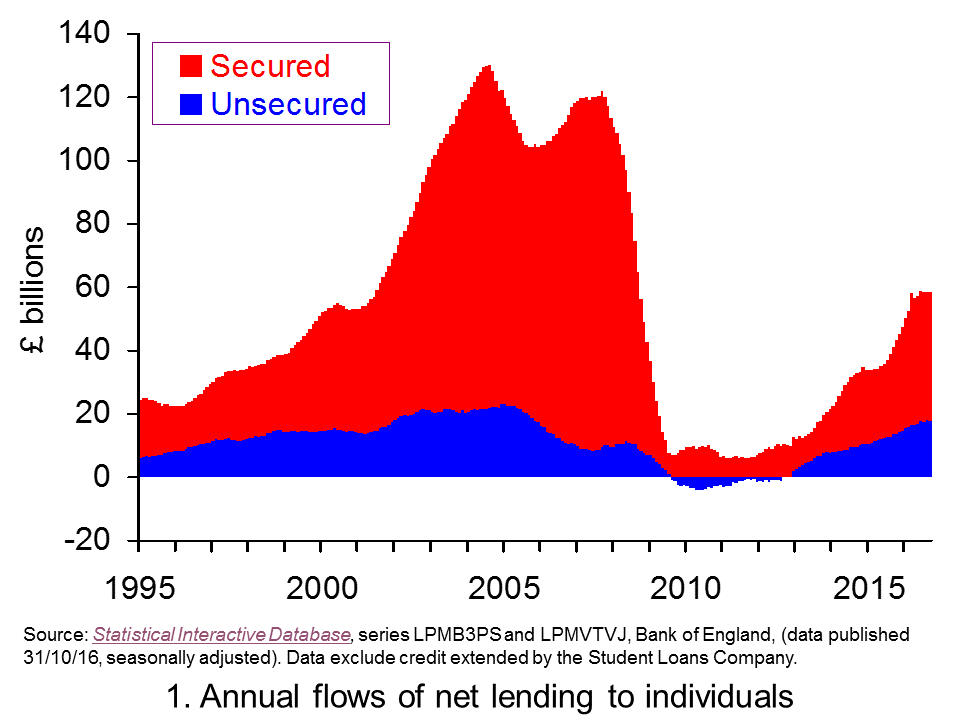 Leaving aside the question of the economic impact of Brexit, we still need to consider what the credit data mean for financial stability and for our financial well-being. Chart 1 shows the annual flows of lending by banks and building societies since the mid 1990s. The chart evidences the cycles in secured lending and in consumer credit (unsecured lending) with its consequent implications for economic and financial-welling being.(Click here to download a PowerPoint of Chart 1.)
Leaving aside the question of the economic impact of Brexit, we still need to consider what the credit data mean for financial stability and for our financial well-being. Chart 1 shows the annual flows of lending by banks and building societies since the mid 1990s. The chart evidences the cycles in secured lending and in consumer credit (unsecured lending) with its consequent implications for economic and financial-welling being.(Click here to download a PowerPoint of Chart 1.)

After the financial crisis, as Chart 1 shows, net lending to individuals collapsed. More recently, net lending has been on the rise both through secured lending and in consumer credit. The latest data show that annual flows have begun to plateau. Nonetheless, the total flow of credit in the 12 months to September of £58 billion compares with £33 billion and £41 billion in the 12 months to September 2014 and 2015 respectively. Having said this, in the 12 months to September 2007 the figure was £112 billion! £58 billion is currently equivalent to around about 3 per cent of GDP.
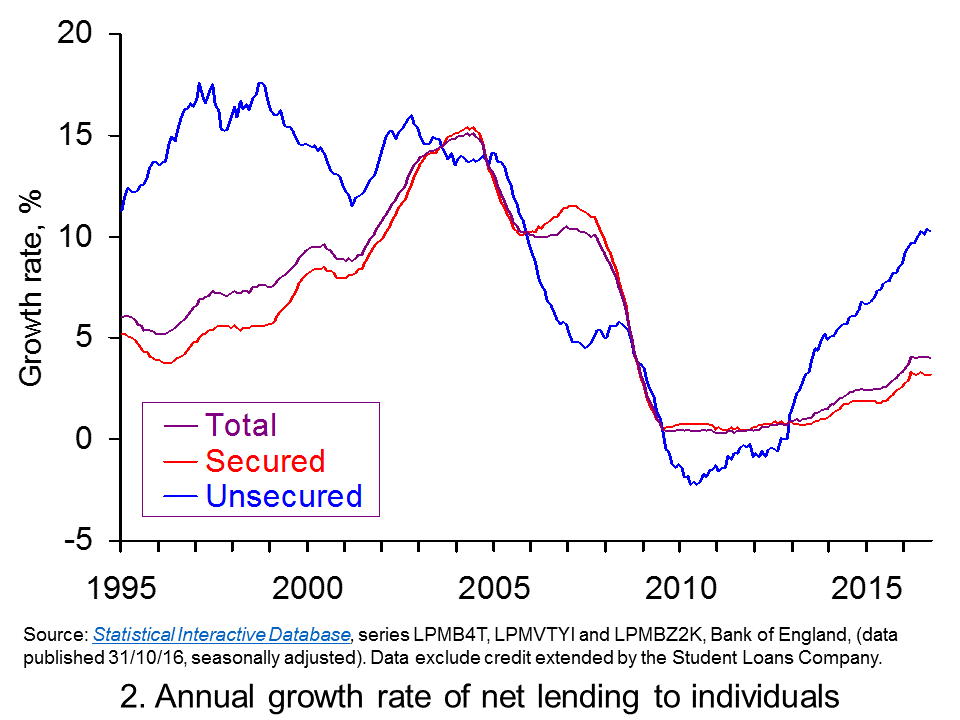 To more readily see the effect of the credit flows on debts stocks, Chart 2 shows the annual growth rate of net lending by MFIs. In essence, this mirrors the growth rate in the stocks of debt which is an important metric of financial well-being. The chart nicely captures the pick up in the growth of lending from around the start of 2013. What is particularly noticeable is the very strong rates of growth in net unsecured lending from MFIs. The growth of unsecured lending remains above 10 per cent, comparable with rates in the mid 2000s. (Click here to download a PowerPoint of Chart 2.)
To more readily see the effect of the credit flows on debts stocks, Chart 2 shows the annual growth rate of net lending by MFIs. In essence, this mirrors the growth rate in the stocks of debt which is an important metric of financial well-being. The chart nicely captures the pick up in the growth of lending from around the start of 2013. What is particularly noticeable is the very strong rates of growth in net unsecured lending from MFIs. The growth of unsecured lending remains above 10 per cent, comparable with rates in the mid 2000s. (Click here to download a PowerPoint of Chart 2.)
The growth in debt stocks arising from lending continues to demonstrate the need for individuals to be mindful of their financial well-being. This caution is perhaps more important given the current economics uncertainties. The role of the Financial Policy Committee in the UK is to monitor the financial well-being of economic agents in the context of ensuring the resilience of the financial system. It therefore analyses the data on credit flows and debt stocks referred to in this blog along with other relevant metrics. At this moment its stance is not to apply any additional buffer – known as the Countercyclical Capital Buffer – on a financial institution’s exposures in the UK over and above internationally agreed standards. Regardless, the fact that it explicitly monitors financial well-being and risk shows just how significant the relationship between the financial system and economic outcomes is now regarded.
Articles
Higher inflation and rising debt threaten millions in UK The Guardian, Angela Monaghan (5/11/16)
Consumer spending has saved the economy in the past – but we cannot bet on it forever Sunday Express, Geff Ho (13/11/16)
Warning as household debts rise to top £1.5 trillion BBC News, Hannah Richardson (7/11/16)
Household debt hits record high – How to get back on track if you’re in the red Mirror, Graham Hiscott (7/12/16)
Data
Money and Credit – September 2016 Bank of England
Bankstats (Monetary and Financial Statistics) – Latest Tables Bank of England
Statistical Interactive Database Bank of England
Questions
- Explain the difference between secured debt and unsecured debt.
- What does it mean if individuals are financially distressed?
- How would we measure the financial well-being of individuals and households?
- What actions might individuals take it they are financially distressed? What might the economic consequences be?
- How might uncertainty, such as that following the UK vote to leave the European Union, affect spending and savings’ decisions by households?
- What measures can institutions, like the UK’s Financial Policy Committee, take to reduce the likelihood that flows of credit become too excessive?
 Household borrowing on credit cards and through overdrafts and loans has been growing rapidly. This ‘unsecured’ borrowing is now rising at rates not seen since well before the credit crunch of 2008 (click here for a PowerPoint of the chart below). Should this be a cause for concern?
Household borrowing on credit cards and through overdrafts and loans has been growing rapidly. This ‘unsecured’ borrowing is now rising at rates not seen since well before the credit crunch of 2008 (click here for a PowerPoint of the chart below). Should this be a cause for concern? But there could be trouble ahead! Secured borrowing (i.e. on mortgages) is at record highs as house prices have soared, limiting the amount people have to left to spend, even with ultra low interest rates. Student debt is growing, putting a brake on graduate spending.
But there could be trouble ahead! Secured borrowing (i.e. on mortgages) is at record highs as house prices have soared, limiting the amount people have to left to spend, even with ultra low interest rates. Student debt is growing, putting a brake on graduate spending.








